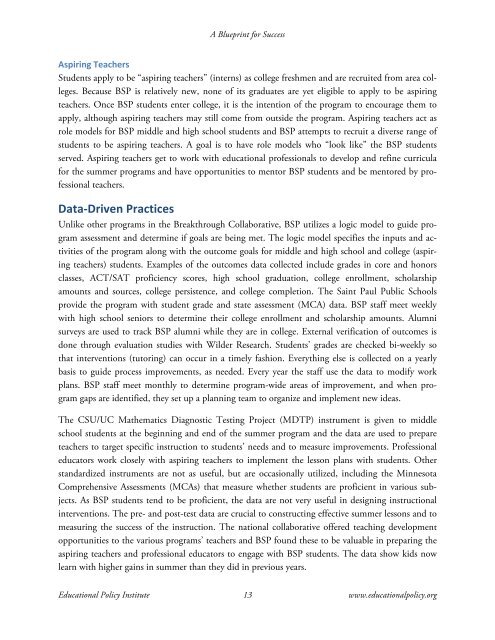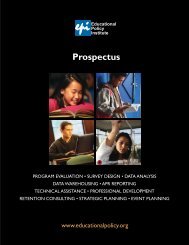A BluePrint for Success: Case Studies of Successful - Educational ...
A BluePrint for Success: Case Studies of Successful - Educational ...
A BluePrint for Success: Case Studies of Successful - Educational ...
Create successful ePaper yourself
Turn your PDF publications into a flip-book with our unique Google optimized e-Paper software.
A Blueprint <strong>for</strong> <strong>Success</strong><br />
Aspiring Teachers<br />
Students apply to be “aspiring teachers” (interns) as college freshmen and are recruited from area colleges.<br />
Because BSP is relatively new, none <strong>of</strong> its graduates are yet eligible to apply to be aspiring<br />
teachers. Once BSP students enter college, it is the intention <strong>of</strong> the program to encourage them to<br />
apply, although aspiring teachers may still come from outside the program. Aspiring teachers act as<br />
role models <strong>for</strong> BSP middle and high school students and BSP attempts to recruit a diverse range <strong>of</strong><br />
students to be aspiring teachers. A goal is to have role models who “look like” the BSP students<br />
served. Aspiring teachers get to work with educational pr<strong>of</strong>essionals to develop and refine curricula<br />
<strong>for</strong> the summer programs and have opportunities to mentor BSP students and be mentored by pr<strong>of</strong>essional<br />
teachers.<br />
Data-‐Driven Practices<br />
Unlike other programs in the Breakthrough Collaborative, BSP utilizes a logic model to guide program<br />
assessment and determine if goals are being met. The logic model specifies the inputs and activities<br />
<strong>of</strong> the program along with the outcome goals <strong>for</strong> middle and high school and college (aspiring<br />
teachers) students. Examples <strong>of</strong> the outcomes data collected include grades in core and honors<br />
classes, ACT/SAT pr<strong>of</strong>iciency scores, high school graduation, college enrollment, scholarship<br />
amounts and sources, college persistence, and college completion. The Saint Paul Public Schools<br />
provide the program with student grade and state assessment (MCA) data. BSP staff meet weekly<br />
with high school seniors to determine their college enrollment and scholarship amounts. Alumni<br />
surveys are used to track BSP alumni while they are in college. External verification <strong>of</strong> outcomes is<br />
done through evaluation studies with Wilder Research. Students’ grades are checked bi-weekly so<br />
that interventions (tutoring) can occur in a timely fashion. Everything else is collected on a yearly<br />
basis to guide process improvements, as needed. Every year the staff use the data to modify work<br />
plans. BSP staff meet monthly to determine program-wide areas <strong>of</strong> improvement, and when program<br />
gaps are identified, they set up a planning team to organize and implement new ideas.<br />
The CSU/UC Mathematics Diagnostic Testing Project (MDTP) instrument is given to middle<br />
school students at the beginning and end <strong>of</strong> the summer program and the data are used to prepare<br />
teachers to target specific instruction to students’ needs and to measure improvements. Pr<strong>of</strong>essional<br />
educators work closely with aspiring teachers to implement the lesson plans with students. Other<br />
standardized instruments are not as useful, but are occasionally utilized, including the Minnesota<br />
Comprehensive Assessments (MCAs) that measure whether students are pr<strong>of</strong>icient in various subjects.<br />
As BSP students tend to be pr<strong>of</strong>icient, the data are not very useful in designing instructional<br />
interventions. The pre- and post-test data are crucial to constructing effective summer lessons and to<br />
measuring the success <strong>of</strong> the instruction. The national collaborative <strong>of</strong>fered teaching development<br />
opportunities to the various programs’ teachers and BSP found these to be valuable in preparing the<br />
aspiring teachers and pr<strong>of</strong>essional educators to engage with BSP students. The data show kids now<br />
learn with higher gains in summer than they did in previous years.<br />
<strong>Educational</strong> Policy Institute 13 www.educationalpolicy.org




